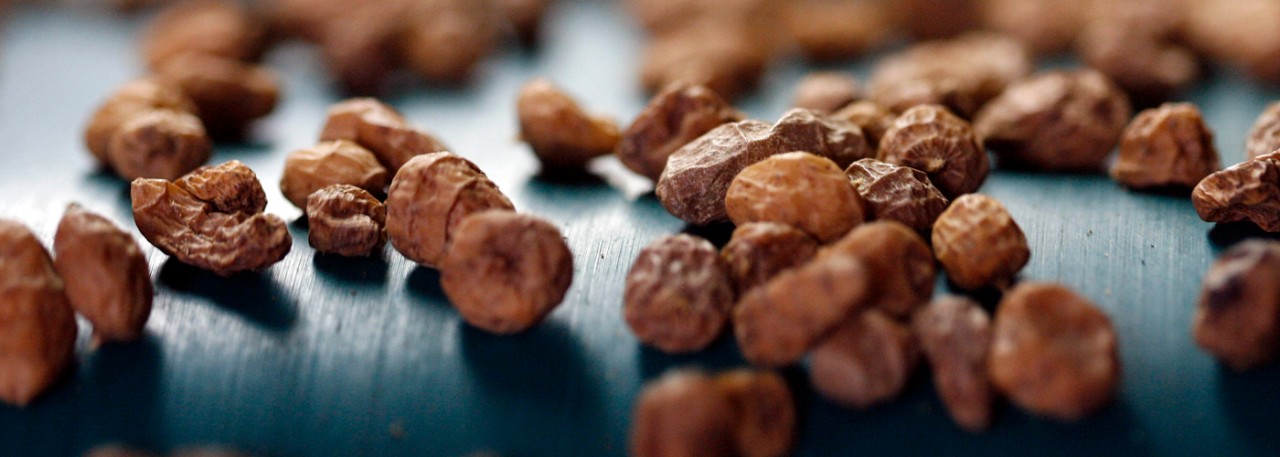.png.transform/rendition-xs/image_image%20(1).png)
Chufa de Valencia PDO
The tiger nut, Cyperus esculentus, is a perennial plant growing from a rhizome. The leaves grow in a rosette shape and the plant measures 40 to 50 cm / 15-19 in. The tiger nuts form at the end of the tiny roots and may be either elongated or rounded. Tiger nuts are especially well-known as the ingredient of the popular Spanish Summer drink called horchata.
Tasting notes
Delicate aroma, and sweet, almond-like flavor.
Other notes
The tubers become edible and obtain their flavor after they have been dried when part of the starch content is converted into sugar. They are a dark beige color and have a characteristically rough outside surface. The unit weight is 0.45-0.80 g when fresh. Morphology of young tiger nuts: 0.9-1.6 cm (3/8-3/4") in length, and 0.7-1.1 cm (1/4-1/2") in width. Dry matter content by weight: Sugars: 11-17.5%; Fat: 23-31%; Protein: 6.5-12%; Starch: 25-40%. Tolerances allowed:
-Hollow or semi-hollow tubers: maximum 0.4% in weight.
-Dark brown or chocolate-colored tubers, or with organoleptic alterations: maximum 0.6% in weight.
-Tubers with damage to the skin, with blemishes or segments: maximum 1% in weight.
-Foreign matter: 0.1%.
-Free of pests and contaminating or toxic residue.
Production / Processing method
The cultivation of PDO tiger nuts in Valencia forms part of the crop rotation system (potatoes, onions, peanuts, lettuce, etc.). Planting takes place outdoors in spring, preferably in April, and harvesting in autumn (November-December). The land must first be prepared to break up any waste from the previous crop. This is done using a rotary cultivator, preferably in crosswise directions. Lands about 4 m across are then formed for irrigation by flooding. When the soil is ready for sowing, the rotary cultivator turns it once more then planting is done either manually or by machine. Tuber density varies depending on the time of planting but is about 120-140 kg per hectare (2.471 acres) for early or medium crops. When ready, the leaves are either pulled or burnt off. The field is then cleared by removing any plant remains not damaged by fire using manual rakes or animal or tractor-drawn mechanical rakes. A conveyor belt lifts the soil plus tiger nuts to the separation drum which removes the soil and retains the tiger nuts. These are then unloaded forming big piles or onto trailers to be transferred for washing. The subsequent process is as follows:
- Washing, to remove any impurities. The resulting tiger nuts contain about 45-50% moisture and are called young tiger nuts.
- Drying is performed with the regulatory timing, temperature and ventilation. The tubers are then placed in layers 10-20 cm deep and turned over once or twice a day. This stage lasts for 3 months.
- The dried tiger nuts are then checked to remove any hollow, damaged or blemished tubers and impurities.
- The clean, dried tiger nuts are classified by size.
- The classified, dried tiger nuts are packed and prepared for dispatch to the market or to horchata production plants.
- External quality control, to guarantee that the packs have the right weight, are free of foreign matter or defective tiger nuts and comply with the tolerances laid down in the regulations.
- Labeling , including numbered back-labels.
Geography / Relief and climate
The soils are loamy-sandy, and must be well-drained and leveled. The texture must be light and loose with fine sand, and free of salinity and weeds. This type of soil gives good-quality tiger nuts with a sweeter, more intense flavor, thinner skin and a larger, more uniform size.
The production area is flat, as is typical of sedimentary areas along the Mediterranean coast. The climate is Mediterranean, with high relative humidity and little change in temperature during the day because of the moderating effect from the sea. This high relative humidity is good for the crop because rainfall is low. A network of irrigation channels brings water from the Turia river during the summer months.
Regulatory Council
Consejo Regulador de la DOP Chufa de Valencia
Pza. de la Constitución, 17
46120 Alboraya (Valencia)
Tel: (+34) 963 690 499
info@chufadevalencia.org
www.chufadevalencia.org
Sources:
Tiger nut and tiger nut horchata it is slightly rich in iron and calcium. Contains no lactose and is free from gluten.


- /content/dam/en/icex-foodswines/images/products/fruits---vegetables/chufa-de-valencia-pdo/Chufa%20de%20Valencia%20PDO%20carr1.jpg
- /content/dam/en/icex-foodswines/images/products/fruits---vegetables/chufa-de-valencia-pdo/Chufa%20de%20Valencia%20PDO%20carr2.jpg

Valencia (Valencian Community)
